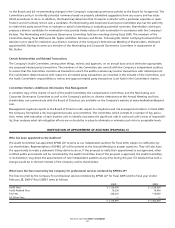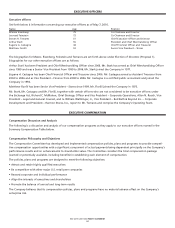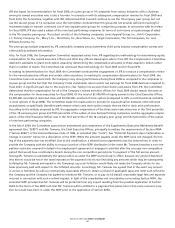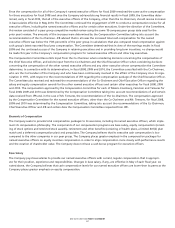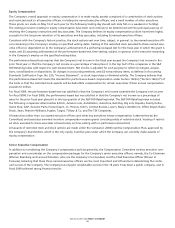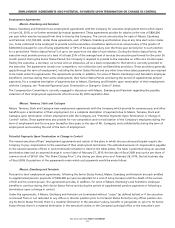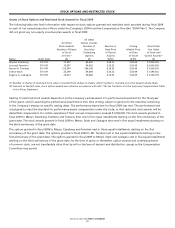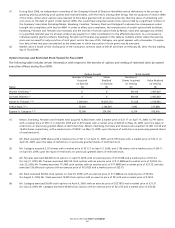Bed, Bath and Beyond 2009 Annual Report Download - page 52
Download and view the complete annual report
Please find page 52 of the 2009 Bed, Bath and Beyond annual report below. You can navigate through the pages in the report by either clicking on the pages listed below, or by using the keyword search tool below to find specific information within the annual report.BED BATH & BEYOND PROXY STATEMENT
50
Other Benefits
The Company provides the named executive officers with the same benefits offered to all other associates. The cost of these ben-
efits constitutes a small percentage of each named executive officer’s total compensation. Key benefits include paid vacation, pre-
miums paid for long-term disability insurance, a matching contribution to the named executive officer’s 401(k) plan account, and
the payment of a portion of the named executive officer’s premiums for healthcare and basic life insurance.
The Company has a nonqualified deferred compensation plan for the benefit of certain highly compensated associates, includ-
ing the named executive officers. The plan provides that a certain percentage of an associate’s contributions may be matched by
the Company, subject to certain limitations. This matching contribution will vest over a specified period of time. See “Deferred
Compensation” below.
The Company provides the named executive officers with certain perquisites including tax preparation services and car service, in
the case of Messrs. Eisenberg and Feinstein, and a car allowance, in the case of all named executive officers. The Compensation
Committee believes all such perquisites are reasonable and consistent with its overall objective of attracting and retaining our
named executive officers.
The Company reviews these other benefits and perquisites on an annual basis and makes adjustments as warranted based on
competitive practices and the Company’s performance.
See the “All Other Compensation” column in the Summary Compensation Table for further information regarding these benefits
and perquisites, and “Potential Payments Upon Termination or Change in Control” below for information regarding termination
and change in control payments and benefits.
Impact of Accounting and Tax Considerations
The Compensation Committee considers the accounting cost associated with equity compensation and the impact of Section
162(m) of the Code, which generally prohibits any publicly held corporation from taking a federal income tax deduction for
compensation paid in excess of $1 million in any taxable year to certain executives, subject to certain exceptions for performance-
based compensation. Stock options and performance-based compensation granted to our named executive officers are intended
to satisfy the performance-based exception and be deductible. Base salary amounts in excess of $1 million are not deductible
by the Company.
Policy on the Recovery of Incentive Compensation
In fiscal 2009, the Board adopted a policy as part of the Company’s corporate governance guidelines on the recovery of incentive
compensation, commonly referred to as a “clawback policy,” applicable to the Company’s named executive officers (as defined
under Item 402(a)(3) of Regulation S-K).
Advisory Vote on Executive Compensation
The Company anticipates that non-binding advisory votes on compensation practices, commonly referred to as “say-on-pay,” may
in the future be mandated by law, in which case the Company will comply with such requirements.
In any event, if no such advisory vote is required by law at the time of the Company’s 2011 Annual Meeting, the Board has
approved in principle that, effective with the Company’s 2011 Annual Meeting, the Company will implement a non-binding, advi-
sory vote by the Company’s shareholders on the Compensation Committee’s compensation philosophy, policies and procedures
for the Company’s named executive officers.
Conclusion
After careful review and analysis, the Company believes that each element of compensation and the total compensation provided
to each of its named executive officers is reasonable and appropriate. The value of the compensation payable to the named
executive officers is significantly tied to the Company’s performance and the return to its shareholders over time. The Company
believes that its compensation programs will allow it to attract and retain a top performing management team.




